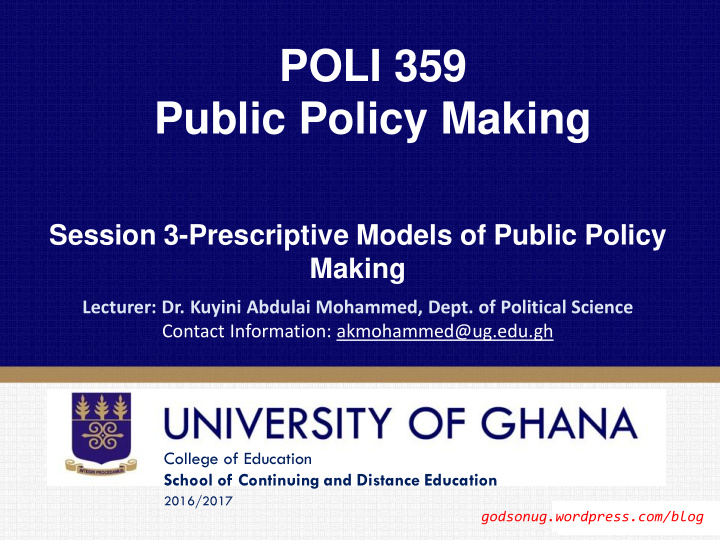



POLI 359 Public Policy Making Session 3-Prescriptive Models of Public Policy Making Lecturer: Dr. Kuyini Abdulai Mohammed, Dept. of Political Science Contact Information: akmohammed@ug.edu.gh College of Education School of Continuing and Distance Education 2016/2017 godsonug.wordpress.com/blog
Prescriptive Models Prescriptive models stipulate how public policies ought to be made. Prescriptive models of policy making include: • Rational Comprehensive Model • Incremental Model • Mixed Scanning Model • Garbage Can Model • Normative optimum Model • Public Choice Model Slide 2
Rational Comprehensive Model A rational comprehensive approach to decision making involves the following: • A problem is identified and well defined. • The values, goals, and objectives of the decision makers are made explicit and ranked in order of priority. • All options that could achieve the goal are identified. • The costs and benefits of each option are then compared. • The decision maker chooses the option with the greatest benefits and the least costs. Slide 3
Strengths of the Rational Comprehensive Model Advantages: • It is a useful tool of analysis. • It helps to identify barriers to rationality. • It is the best possible decision making approach. • Rational decisions may make either large and basic or limited changes in public policies. • It forces decision makers to strive to make decisions that most effectively achieve a given end. Slide 4
Weakness of the Rational Comprehensive Model • Decision makers are not faced with concrete, clearly identified problems. • It is unrealistic in the intellectual demands on decision makers. • Decision maker are faced with value conflict. • Decision makers may confuse personal values with public values. • There is the problem of sunk cost. Slide 5
Incremental Model/Incrementalism • Incrementalism is a decision making model that is characterized by limited analysis. • The analysis yields decision that differ only marginally from previous decisions. • Incremental decision making is characterized by bargains and concessions among self-interested decision makers. • It involves minor changes to existing policies. • National budget making is an example of incremental decision making. Slide 6
Characteristics of the Incremental Model • Goals and objectives are selected. • Empirical analysis to attain the goals are intertwined with rather than separate from each other. • Only some of the alternatives for dealing with the problem are considered. • For each alternative only a limited number of consequences are evaluated. • The problem facing the decision maker is continually redefined. Slide 7
Characteristics of the Incremental Model • The model allows for countless ends-means and means-ends adjustment. • There is no single or right decision for a problem. • The test of a good decision is that various analysts find themselves directly agreeing on it. • However, they do not agree that the decision is the most appropriate means to achieve the objective. • Incremental decision making is essentially remedial. Slide 8
Advantages of the Incremental Model • The incremental process is politically expedient. • It reduces risks and costs of uncertainty. • It is realistiĐ iŶ reĐogŶiziŶg the deĐisioŶ ŵaker’s laĐk of information and other resources for acting rationally. • It achieves limited, practical and acceptable decisions. • Incremental decision is evident in pluralistic societies such as the US. Slide 9
Weakness of the Incremental Model • It is too conservative and too focused on the existing order. • It is a barrier to innovation which is required for effective policies. • In situations of crisis and major changes in decision, it provides no guidelines. • It discourages the search for or use of other readily available alternatives. • It does not eliminate the need for theory in decision making. Slide 10
Public Choice Model • Public choice model is the application of economic analysis to political and social phenomena. • It is the economic study of non market decision making. • It argues that the behaviour of individuals is towards self- interest maximization. • Self-interest of the individual is evident whether in the political or market arenas. • Politicians want to maximize votes, bureaucrats strive to maximize departmental budgets, voters maximize personal benefits. Slide 11
PuďliĐ ChoiĐe Model ;ĐoŶt’d: • People pursue their self-interest both in politics and the market. • Even if these interests are selfish, they can mutually benefit through collective decision making. • That government itself is a social contract. The contract is between individuals who agree for their mutual benefit to obey law. • These individuals obey laws and support government in return for protection. The protection is for their lives, properties and liberties. Slide 12
Characteristics of the Public Choice Model • It acknowledges that the state is obligated to perform certain functions the market cannot perform. • It rejects the traditional notion that the intent of policy is to serve the public interest. • It insists rather that the intent of policy is to serve the interests of politicians • It claims that the behaviour of actors is opportunistic. • It contends that government is a revenue maximizing leviathan. • This means the state gets maximum taxation revenue. Slide 13
Advantages of the Public Choice Model • It helps in explaining why political parties fail to provide clear policy alternatives. • It has developed its own critique of the simple median-voter model. • It contributes to our understanding of interests groups and their influence on public policy. • It identifies ways of re-orienting actors towards serving the public interest. Slide 14
Weakness of the Public Choice Model • It scores low on moral attractiveness as public policy is modeled only as rent seeking behaviour. • The evidence on public choice model is mixed so it is difficult to derive proper test. • It tends to over-emphasize the supply side in public policy making. • If a demand side argument is raised, tension will arise between it and the supply side argument. Slide 15
Recommend
More recommend